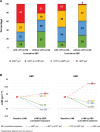Stricter Blood Pressure Control Is Associated With Lower Left Ventricular Mass in Children After Kidney Transplantation: A Longitudinal Analysis of the 4C-T Study
- PMID: 37462031
- PMCID: PMC10424823
- DOI: 10.1161/HYPERTENSIONAHA.123.21187
Stricter Blood Pressure Control Is Associated With Lower Left Ventricular Mass in Children After Kidney Transplantation: A Longitudinal Analysis of the 4C-T Study
Abstract
Background: We assessed the effect of blood pressure (BP) control on left ventricular mass index (LVMI) and left ventricular hypertrophy (LVH).
Methods: Ninety-six patients (64 males) ≥9 months post-kidney transplantation from the 4C-T (Cardiovascular Comorbidity in Children with Chronic Kidney Disease and Transplantation) study were analyzed longitudinally (mean follow-up, 2.6±1.3 years). Cumulative systolic blood pressure (SBP)/diastolic BP exposure was calculated as a time-averaged area under the curve and categorized: ≤50th, 50th to ≤75th, 75th to ≤90th, and >90th percentile (pct). We performed adjusted linear and logistic mixed models for LVMI and LVH, respectively.
Results: At baseline, LVMI was 49.7±12.7g/m2.16 with 64% (n=61) kidney transplantation recipients displaying LVH. Compared with patients with cumulative SBP exposure >90th pct, patients with cumulative SBP of 50th to ≤75th showed a significant LVMI reduction of -5.24g/m2.16 (P=0.007). A similar tendency was seen for cumulative SBP≤50th (β=-3.70 g/m2.16; P=0.067), but patients with cumulative SBP of 75th to ≤90th pct showed no reduction. A post hoc analysis in patients with cumulative SBP≤75th revealed that median SBP exposure was at 57.5th pct. For cumulative diastolic BP, a significant LVMI reduction was seen in all 3 categories ≤90th pct compared with patients >90th pct. Patients with cumulative SBP of ≤50th or 50th to ≤75th pct showed 79% or 83% lower odds of developing LVH, respectively. Patients with cumulative diastolic BP ≤50th showed a tendency of 82% lower odds for LVH (95% CI, 0.03-1.07).
Conclusions: Stricter BP control led to regression of LVMI and LVH. Our data suggest a BP target below the 60th pct, which needs to be substantiated in a randomized controlled trial.
Keywords: cardiovascular disease; hypertension; hypertrophy, left ventricular; pediatric nephrology; prospective study.
Conflict of interest statement
Figures

References
-
- Bonthuis M, Vidal E, Bjerre A, Aydog O, Baiko S, Garneata L, Guzzo I, Heaf JG, Jahnukainen T, Lilien M, et al. . Ten-year trends in epidemiology and outcomes of pediatric kidney replacement therapy in europe: data from the espn/era-edta registry. Pediatr Nephrol. 2021;36:2337–2348. doi: 10.1007/s00467-021-04928-w - PMC - PubMed
-
- McDonald SP, Craig JC; Australian and New Zealand Paediatric Nephrology Association. Long-term survival of children with end-stage renal disease. N Engl J Med. 2004;350:2654–2662. doi: 10.1056/NEJMoa031643 - PubMed
-
- Doyon A, Kracht D, Bayazit AK, Deveci M, Duzova A, Krmar RT, Litwin M, Niemirska A, Oguz B, Schmidt BM, et al. ; 4C Study Consortium. Carotid artery intima-media thickness and distensibility in children and adolescents: reference values and role of body dimensions. Hypertension. 2013;62:550–556. doi: 10.1161/HYPERTENSIONAHA.113.01297 - PubMed
Publication types
MeSH terms
LinkOut - more resources
Full Text Sources
Medical

